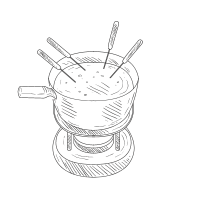Fondue Burner: Your Guide to Melted Delights
Fondue, the Swiss culinary masterpiece, evokes images of warm, shared experiences and delectable dips. Whether you’re a seasoned fondue aficionado or a curious newcomer, the heart of this culinary adventure lies in a reliable fondue burner. This comprehensive guide delves deep into the world of fondue burners, equipping you with the knowledge to master this essential tool and unlock a world of melted deliciousness.
Types of Fondue Burners: Navigating the Options
Choosing the right fondue burner sets the stage for a seamless fondue experience. Let’s explore the most popular types:
1. Spirit Burners: The Classic Choice
Spirit burners, often fueled by denatured alcohol or methylated spirits, are the traditional choice for fondue. They offer a gentle, consistent heat, perfect for maintaining the ideal fondue consistency.
Advantages:
- Even heat distribution
- Easy to adjust flame intensity
- Classic, elegant aesthetic
Disadvantages:
- Requires regular refilling of fuel
- Open flame requires caution
- Fuel can be flammable
2. Gel Fuel Burners: Convenience and Safety
Gel fuel burners utilize pre-filled canisters of gel fuel, offering a convenient and relatively safe option.
Advantages:
- Easy to use and replace fuel
- Relatively safe with no open flame
- Portable and easy to store
Disadvantages:
- Heat output can be less intense than spirit burners
- Disposal of canisters can be an environmental concern
3. Electric Fondue Burners: Modern Precision
Electric fondue burners provide precise temperature control and eliminate the need for open flames or fuels.
Advantages:
- Accurate temperature settings
- No need for fuels or open flames
- Easy to clean
Disadvantages:
- Requires an electrical outlet
- May not have the same aesthetic appeal as traditional burners
4. Butane Burners: Powerful and Adjustable
Butane burners, often used for camping stoves, can also be used for fondue. They offer powerful heat and adjustable flames.
Advantages:
- High heat output
- Adjustable flame intensity
- Butane canisters are widely available
Disadvantages:
- Can be bulky for fondue settings
- Open flame requires caution
Essential Fondue Burner Accessories
Enhance your fondue experience with these essential accessories:
1. Fondue Pot: The Vessel of Deliciousness
The fondue pot, often made of ceramic, stainless steel, or cast iron, is where the magic happens. Choose a pot with a wide base for stability and a heavy bottom for even heat distribution.
2. Fondue Forks: Dipping with Elegance
Long-stemmed fondue forks with two or three prongs are designed for easy dipping and swirling.
3. Fondue Plate: A Hub for Flavor
A fondue plate provides designated spaces for dipping sauces, garnishes, and bread, keeping your fondue setup organized and inviting.
Mastering the Art of Using a Fondue Burner
Now that you’re familiar with the different types of fondue burners and essential accessories, let’s delve into the art of using them:
1. Preparing the Burner
- Spirit Burner: Fill the burner reservoir with denatured alcohol or methylated spirits, leaving some space at the top.
- Gel Fuel Burner: Open the gel fuel canister and place it in the designated area of the burner.
- Electric Burner: Plug in the burner and adjust the temperature setting according to the fondue recipe.
- Butane Burner: Attach the butane canister to the burner and follow the manufacturer’s instructions for ignition.
2. Heating the Fondue
- Place the fondue pot over the burner and adjust the flame or temperature to a low setting initially.
- Gradually increase the heat as needed, stirring the fondue occasionally to prevent sticking or burning.
3. Maintaining the Fondue
- Once the fondue reaches the desired consistency, adjust the heat to a low setting to maintain the temperature.
- Stir the fondue occasionally to ensure even heating.
- For spirit burners, monitor the fuel level and refill as needed, being cautious of the flame.
4. Safety First
- Always use caution when handling open flames or hot surfaces.
- Keep a fire extinguisher nearby for emergencies.
- Never leave a lit burner unattended.
- Allow the burner to cool completely before handling or cleaning.
Beyond the Cheese: Exploring Fondue Varieties
Fondue is incredibly versatile, extending far beyond the realm of melted cheese. Let’s explore some delectable variations:
1. Cheese Fondue: The Classic Indulgence
Swiss cheese fondue, often made with Gruyère and Emmental, is a timeless classic. Dip crusty bread, boiled potatoes, or crisp vegetables into the warm, cheesy goodness.
2. Chocolate Fondue: A Sweet Delight
Indulge your sweet tooth with a rich chocolate fondue. Dip fresh fruit, marshmallows, or brownie bites into the decadent melted chocolate.
3. Meat Fondue: A Savory Adventure
Explore the savory side of fondue with a meat fondue, often using broth or oil as the base. Diners cook small pieces of meat, seafood, or vegetables in the hot liquid, creating a personalized and interactive dining experience.
Conclusion: Embrace the Fondue Experience
A fondue burner is more than just a kitchen tool; it’s a gateway to shared moments, culinary creativity, and pure indulgence. Whether you’re hosting a gathering or enjoying a cozy evening in, let the warmth of the fondue burner and the deliciousness of melted goodness create unforgettable experiences.

